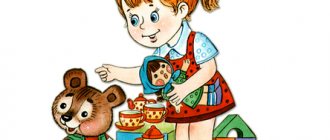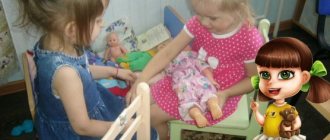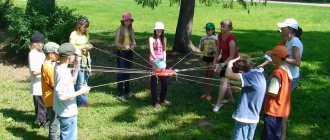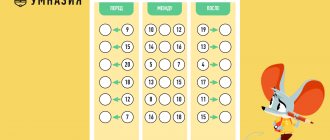Meaning and types of games
Children's games for the entire period of Soviet education were not collected, not generalized, that is, not classified. The famous psychologist A. N. Leontiev rightly Fr.
The most common theories of the game in the 19th and 20th centuries:
K. Gross believed that play is the unconscious preparation of a young organism for life.
K. Schiller, G. Spencer explained the game as a simple waste of excess energy that the child accumulates. It is not used for work and is therefore expressed in play activities.
K. Bühler emphasized the usual enthusiasm with which children play, arguing that the whole point of play lies in the pleasure it gives the child.
Z. Freud believed that a child is encouraged to play by his own feeling of inferiority.
Although these explanations of play seem different, all these authors argue that the basis of play is the instinctive, biological needs of the child: his drives and desires.
Russian and Soviet scientists have a fundamentally different approach to explaining the game:
A. I. Sikorsky, P. F. Kapterev, P. F. Lesgat, K. D. Ushinsky prove the uniqueness of the game as a truly human activity.
N. Krupskaya, A.S. Makarenko, and then many teachers and psychologists deepened the analysis of the game and strictly scientifically explained this peculiar children's activity.
Children's games are characterized by the following features:
- play is a form of active reflection by a child of the human life around him.
- The peculiarity of the game is precisely the method that the child uses in this activity.
- the game, like any other human activity, is social by nature, so it changes with changes in the historical conditions of people's lives
- play is a form of creative reflection of reality by a child.
- play is an operation of cognition, a means of clarification and enrichment, a way of exercising and, consequently, developing the cognitive and moral abilities and strengths of the child.
6) In its developed form, play is a collective activity.
7.Diverse development of children, the game itself also changes and develops.
There are different types of games: Movement, didactics, drama, constructive games.
In early childhood, elements of role-playing play appear and begin to form. In role-playing games, children satisfy their desire to live with adults and, in a special, playful form, reproduce the relationships and work activities of adults.
A. N. Leontyev, D. B. Elkonin, A. V. Zaporozhets called role-playing the leading activity of a preschool child. Role-playing play arises and exists in combination with other types of children's exercises: first of all, with observations of the surrounding life, listening to stories and conversations with adults.
D. B. Elkonin, based on an analysis of ethnographic research, came to the conclusion that role-playing game arose during the historical development of society, as a result of a change in the child’s place in the system of social relations, that is, it is social in origin. The emergence of play is not associated with the action of some innate, instinctive forces, but with certain conditions of the child’s life in society. Childhood dragged on, and with the advent of role-playing games, a new stage in the mental development of the child arose - preschool age. D.B. Elkonin emphasized that the extension of childhood occurs not by superimposing a new period on an existing one, but by wedging it in a way.
The game is social not only in its origin, but also in its content. All researchers who describe role-playing note that it has a great influence on the child’s surrounding reality; the actions of children’s games are determined by the social, everyday, and family conditions of the child’s life.
Classification of games for preschoolers
Yulia Yakovleva
Classification of games for preschoolers
The game occupies a leading place in the system of physical, moral, labor and aesthetic education of preschool children . It activates the child, helps to increase his vitality, satisfies personal interests and social needs.
Despite the invaluable role of play in the life of a preschooler , the organization of play activities in preschool educational institutions requires improvement. She never took her rightful place in the lives of children, which is explained by teachers’ underestimation of her role in the diversified development of preschool children . In many kindergartens, an appropriate play environment has not been created; insufficient attention is paid to the formation of children’s ideas about the world around them, to their amateur games. Subordinating play to learning tasks causes double harm to pupils: it leads to the removal of amateur games from the life of the kindergarten, reduces cognitive motivation, which is the basis for the formation of educational activities. The importance of developing play skills in children has almost completely fallen out of the sight of educators. Sometimes the time allocated for gaming activities is used for educational activities, clubs, preparation for holidays, matinees, etc.
There are three types of games:
1) games initiated by the child (creative,
2) games initiated by an adult with ready-made rules (didactic, outdoor games,
3) folk games (created by the people)
.
Let's look at each of these types.
Creative games make up the most rich typical group of games for preschoolers . They are called creative because children themselves determine the purpose, content and rules of the game, mainly reflecting the life around them, human activities and relationships between people.
A significant part of creative games are role-playing games “playing someone”
or
"into something"
. Children portray people, animals, the work of a doctor, a builder, etc. Realizing that the game is not real life, the kids, meanwhile, truly experience their roles, openly reveal their attitude to life, their thoughts and feelings, and perceive the game as important case. I won’t stop, because Marina Vladimirovna will tell you further.
Role-playing games also include games with elements of labor and artistic and creative activities.
A type of creative play activity is theatrical activity. It is associated with the perception of works of theatrical art and the reproduction in a playful form of acquired ideas, impressions, and feelings. Key concepts of theatrical activity: plot, script, play based on the plot of a literary work, theatricalization, fairy tale translation. Theatrical games are divided depending on their type and specific plot-role content into two main groups: director's games and dramatization games.
In the director's game, the child is like a director and at the same time a “voice-over”
organizes a theatrical playing field in which the actors and performers are dolls. Otherwise, the children themselves act as actors, scriptwriters, and directors, who during the game agree on who will play what role and what to do.
Dramatization games are created based on a ready-made plot from a literary work or theatrical performance. The game plan and sequence of actions are determined in advance. Such a game is more difficult for children than imitating what they see in life, since you need to clearly understand and feel the images of the characters, their behavior, and remember the text of the work (the sequence of actions, the characters’ remarks)
. This is the special significance of dramatization games - they help children to better understand the idea of a work, feel its artistic integrity, and contribute to the development of expressive speech and movements.
Another type is construction games (in the literature they are sometimes mistakenly called constructive)
.
These creative games direct the child’s attention to various types of construction, contribute to the acquisition of organizational design skills and bring children closer together, introducing them to work. It is important that the teacher helps students make the transition from aimless accumulation of material to the creation of a thoughtful idea.
With all the variety of creative games, they have common features: children themselves or with the help of an adult (especially in dramatization games)
choose the theme of the game, develop its plot, distribute roles among themselves, and select the necessary toys. All this should happen under the tactful guidance of an adult, aimed at activating children’s initiative and developing their creative imagination.
Games with rules.
These games provide an opportunity to systematically train children in developing certain skills; they are very important for physical and mental development, character development and will. Children learn games with rules from adults and from each other. Based on the content and methods of playing games with rules, they are divided into two groups: didactic and mobile.
Didactic games contribute mainly to the development of the child’s mental abilities, since they contain mental tasks, the solution of which is the meaning of the game. They also contribute to the development of the child’s senses, attention, memory, and logical thinking. Note: that a didactic game is an effective method of consolidating knowledge, it should not turn into a learning activity. The game captures the child only if it gives joy and pleasure.
An indispensable condition for a didactic game are rules, without which the activity becomes spontaneous.
Outdoor games are important for the physical education of preschoolers , as they contribute to their harmonious development, satisfy the children’s need for movement, and help enrich their motor experience. Two types of outdoor games are carried out with preschool (non-story games)
.
Plot-based outdoor games are based on the child’s experience, his idea of the world around him (the actions of people, animals, birds, which they reproduce with movements characteristic of a particular image. The movements that children perform during the game are closely related to the plot. Most plot-based games Games are collective, in which the child learns to coordinate his actions with the actions of other players, not to be capricious, and to act in an organized manner, as required by the rules.
Game exercises are characterized by specific motor tasks in accordance with the age characteristics and physical fitness of children. If in plot-based outdoor games the main attention of players is aimed at creating images, achieving a specific goal and accurately following the rules, which often leads to ignoring precision in the execution of movements, then during game exercises preschoolers must flawlessly perform basic movements (hitting the ball at the target, crawling under rope, etc.)
.
an important place in senior preschool age: gorodki, table tennis, badminton, basketball, hockey, football, etc.
Folk games are games that originate from ancient times; they are built taking into account ethnic characteristics (round dances, fun, games with folk toys, etc.)
.
They are an integral part of a child’s life in a modern preschool institution , an important source of assimilation of universal human values.
The developmental potential of these games is ensured not only by the presence of appropriate toys, but also by the special creative aura that an adult must create. Folk games reflect the life of people, their way of life, national traditions, they contribute to the education of honor, courage, courage, etc. There are individual, collective, plot, everyday, theatrical games and outdoor fun games. Particularly popular among children are games without a specific plot, built on game tasks that contain a lot of educational material ( magic wand
,
“Zhmurki”
,
“Geese-geese”
, etc.). In these games, the child is required to react quickly and correctly.
To organize games, it is important to create an object-based gaming environment.
An important requirement is the developmental nature and compliance with such principles as the child’s exercise of the right to play (free choice of a toy, theme, plot of the game, place and time of its implementation); the universality of the subject-game environment, so that children, together with teachers, can prepare and change it, transform it according to the design of the game, content, and development prospects; systematicity, that is, the optimal relationship between the individual elements of the game and other objects, etc.
The subject-play environment includes: a large playground, play equipment, toys, a variety of play paraphernalia, and play materials. All these gaming tools are not located in an abstract space, but in a playroom, gym, or playground. There should be nothing unnecessary in the interior; all play equipment should be safe for children.
To conduct games, game cells are created: general (a set of various types of toys, dramatic (sets of equipment, simple decorations, elements of clothing and costumes for dramatization games, staging) for board and construction games (construction sets: wooden, plastic, metal, boxes, blocks and other materials, tools and auxiliary equipment). All equipment should be convenient and easy to transform. Children can independently choose a game, change the center, moving from one game to another.
The leading place in children's play is given to toys. First of all, they should be safe, interesting, attractive, bright, but simple. And not only to attract the child’s attention, but also to awaken and activate his thinking.
All toys can be divided into three types:
1. ready-made toys (cars, planes, dolls, various animals, etc.)
;
2. semi-finished toys (blocks, pictures, construction sets, building material, etc.)
;
3. materials for making toys (sand, clay, wire, twine, cardboard, plywood, wood)
.
With the help of ready-made toys, children are introduced to technology, the environment, and certain images are created. While playing with them, children reproduce their impressions, experience vivid feelings, activate their imagination, and adjust the content of the games.
Semi-finished toys are used primarily for didactic purposes. Manipulating them requires the activation of mental activity in order to complete the tasks set by the teacher: arrange the cubes by size, in order of increasing or decreasing, select a pair from the picture, make some kind of building from the details of a construction set, etc.
Material for creating toys provides great opportunities for developing children's creative imagination. So, depending on their age, they build ships, houses, cars out of sand, and “break” them
There is a small garden in the sandbox; they make dishes and animals from clay. Scraps of wood, twine, and colored paper make a nice car decorated with flags, etc.
It is advisable to combine all three types of toys, because this greatly expands the possibilities for creativity.
A special group includes theatrical toys and costumes for different characters, attributes that complement the created images. This is theatrical play material (toys, dolls, flat figures, finger characters, costume elements (hats, various hats, collars, cuffs, etc.)
.
In kindergartens, doll characters and decorations made by teachers and children themselves are actively used. During the day, children can play four times: before breakfast (5-40 minutes; between breakfast and classes (5-7 minutes; outdoors (1 hour) -1 hour 30 minutes, after a nap (20-40 minutes)
.
Games before breakfast begin when the child arrives at kindergarten, are interrupted by breakfast and continue until the start of classes. The teacher’s task during this period is to rationalize the pedagogical process in such a way as to organize children’s play in effective forms and actively influence its course and the children’s relationships.
In the younger group, preference is given to games in which children could most fully satisfy their needs in play without complex personal relationships. These are games, for example, with sand and water, which can be played at any time of the year, indoors or outdoors.
At preschool age, the child is still interested in toys with which it is possible to perform correlating object actions, as well as natural materials as play objects.
A doll or soft toys play a special role for a preschooler they influence his emotional and moral development. The child is first helped in everything by an adult, from whom he learns to endow the doll with certain positive qualities. A doll or soft toy acts as a substitute for an ideal friend.
The doll not only takes part in all children's games, but also acts as an ideal communication partner and friend. The child performs in relation to the doll the same functions that the adult performs in relation to himself. And this position is another reason for the constant attractiveness of games with dolls for a child. By assessing the doll’s behavior, the child conveys his emotional and moral experience to it, thereby realizing and consolidating it. He acts out all sorts of behaviors with her and evaluates them. Emotional and moral identification arises, moral assessments are formed, a range of emotional experiences develops, and moral qualities are formed.
Dolls - copies of a person have different purposes in the game. In the traditional, “beautiful”
, dolls have big eyes framed by long eyelashes, a short nose, a small bright mouth.
Be sure to have luxurious (white, gold, red, black)
hair.
Such a doll definitely gets a name. “beautiful”
doll can be a princess, a mother, a daughter.
“beautiful”
doll and are a little embarrassed by it.
with “beautiful”
doll.
A characteristic doll (is it a boy doll or a girl doll)
certain human qualities are expressed: naivety, stupidity, mischief, etc. This doll carries a characterological predicament, on which the plot played out with it often depends.
Dolls - heroes of folk and author's fairy tales carry a given image, a stable moral characteristic, despite the changing storylines in the game:
Playing with imaginative toys helps the child protect himself from negative experiences, relieve emotional stress, and compensate for the lack of love and sympathy from adults and peers.
Tool toys (spatulas, molds, buckets, etc.)
- These are smaller copies of adult tools.
In preschool childhood, tool toys are used in other types of games, such as construction games, as well as in work activities.
Technical toys (cars, planes, lunar rovers)
open up the field of technology to the child and introduce it to its use. They push him to experiment, awaken cognitive questions, stimulate the development of technical thinking, and form an idea of the professional activities of adults.
Theatrical toys are used in performances and entertainment. Children endow them with certain traits in accordance with their appearance. Often theatrical toys represent favorite fairy tale characters. They make children want to remember and replay their content. Playing a role with the help of such a toy develops the expressiveness of speech, facial expressions, and pantomimes in a preschooler , and stimulates the development of theatrical and speech abilities.
Homemade toys constitute a special group, since they are created by the child himself with a predetermined play goal. Making such toys develops in a preschooler the ability to create and implement a plan, stimulates creativity, allows one to learn the properties of the material, and forms social motives for behavior, for example, giving a gift to mother or helping children. Homemade toys are a unique way of self-expression and a source of pride. Homemade toys are often multi-functional, which is why they are especially interesting for children.
Fun toys evoke curiosity, joy, and positive emotions in children. They maintain a cheerful mood, develop a sense of humor and curiosity. They encourage children to study their structure, principle of operation, and also create a zone of shared experiences with adults.
At preschool age, the child discovers an interest in competitive games. The attributes of such games are balls, circles, hula hoops, jumping ropes, skittles, bows and arrows and much more. To begin to compete with peers, a child must master these subjects. It is at preschool age that children begin to train purposefully and master the attributes of competitions. In parallel with these trainings, children learn the rules of a particular game. From his desire to win, such personal qualities as restraint, reflection develop (the ability to realize one’s characteristics, realize how these characteristics are perceived by others, and build one’s behavior taking into account the possible reactions of others, the will to win. Sports and motor toys contribute not only to the formation basic movements, but also the development of spatial orientation, properties of attention, such volitional qualities as organization, courage, endurance, initiative.
When choosing toys, children's gender also affects them.
What is important for a child is not the number of toys, but their variety in accordance with the age of the child and the situation of their use. The main task of adults is to teach the child to act with toys.
The role of play in the mental development of a child
Play is the leading activity in preschool age and has a significant impact on the development of the child.
In play activities, the child’s mental qualities and personal characteristics are most intensively formed. Other types of activities are formed in the game, which then acquire independent value.
Play affects all aspects of mental development, which is constantly emphasized by both teachers and psychologists. For example, Makarenko wrote: “Game is important in a child’s life, it has the same value as an adult’s activity, work, service. What a child is like in the game is how he will work in many ways when he grows up. Therefore, the training of the future actor occurs primarily in the game. And the entire history of man as a worker or employee can be represented in the development of play and its gradual transition into work.
Gaming activity influences the formation of the volitional nature of mental processes. Thus, in the game the child begins to develop voluntary attention and voluntary memory. In a playful environment, children concentrate better and remember better. A conscious goal is given to the child earlier and easier in the game. The conditions of the game themselves require the child to concentrate attention on the objects contained in the game situation, on the content of the actions being played out and the plot. If a child does not want to pay attention to what is required of him in the upcoming game situation, if he does not remember the conditions of the game, his peers will simply drive him away.
The game situation of action in it has a constant impact on the development of the mental activity of a preschool child. In the game, the child learns to act with a substitute object - he gives the substitute object a new game name and acts with it in accordance with this name. Gradually, play actions with objects are reduced, the child learns to think about objects and mentally act with them. Thus, play makes a significant contribution to the child's gradual transition to thinking in terms of ideas.
At the same time, the experience of play and, above all, the child’s real relationships in role-playing play lays the foundations for a special quality of thinking, allows the child to put himself in the point of view of others, anticipate their future behavior and base his own behavior on it.
Role-playing games have a certain value for the development of imagination.
The influence of the game on the development of the child’s personality lies in the fact that through it he learns about the behavior and relationships of adults, who become models for his own behavior, and in it he acquires basic communication skills, qualities necessary for contact with peers. By capturing the child and forcing him to follow the rules contained in the assumed role, play contributes to the development of feelings and voluntary regulation of behavior.
At different stages of preschool childhood, the child’s productive activities - drawing, design - are closely related to play. Interest in drawing and design initially arises as a playful interest aimed at the process of forming a drawing or design in accordance with the game plan. Only in middle and older preschool age does interest shift to the result of the activity, and it is freed from the influence of the game.
Within the framework of gaming activities, educational activities begin to form, which subsequently become the leading activities. Learning is introduced by adults, it does not occur directly during the game. But a preschooler begins to learn through play—he calls learning a kind of role-playing game with certain rules. However, by following these rules, the child quietly masters basic learning activities.
Article on the topic: “Games with rules”
GAMES WITH RULES
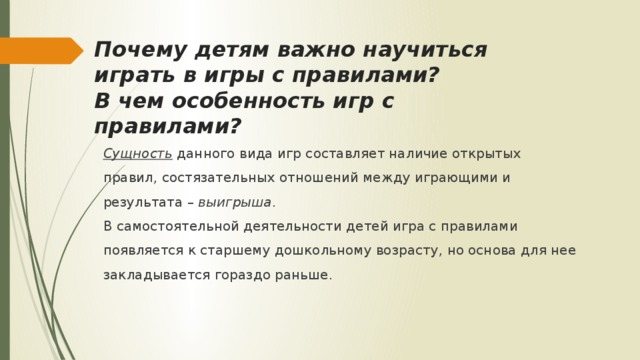
Why is it important for children to learn to play games with rules?
What is special about games with rules?
Essence
This type of game consists of the presence of open rules, competitive relations between the players and the result -
winning
. In children's independent activities, play with rules appears by older preschool age, but the foundation for it is laid much earlier.
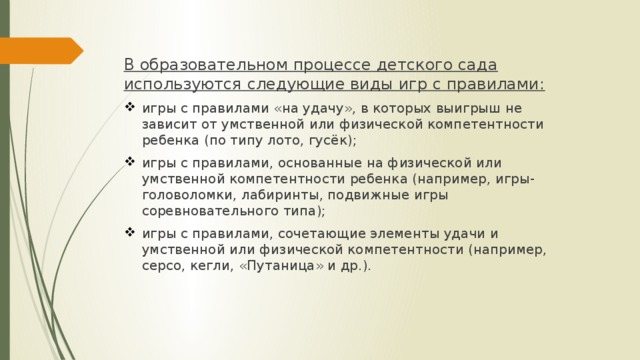
The following types of games with rules are used in the educational process of kindergarten:
- games with “luck” rules, in which winnings do not depend on the child’s mental or physical competence (like lotto, goose);
- games with rules based on the child's physical or mental competence (for example, puzzle games, mazes, competitive outdoor games);
- games with rules that combine elements of luck and mental or physical competence (for example, serso, skittles, “Confusion”, etc.).
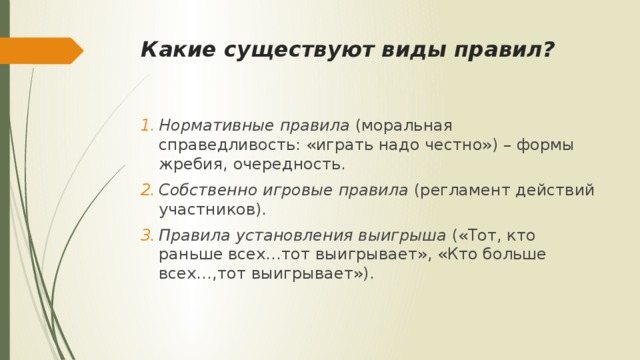
What types of rules are there?
- Normative rules
(moral justice: “one must play fairly”) – forms of drawing lots, taking turns. - The actual game rules
(regulations for the actions of participants). - Rules for establishing winnings
(“The one who is the earliest… wins”, “The one who has the most… wins”).
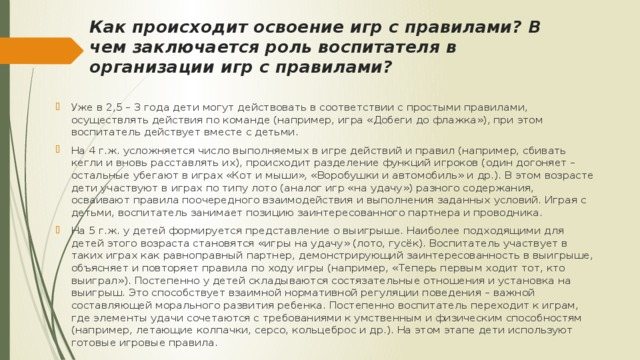
How do you master games with rules? What is the role of the teacher in organizing games with rules?
- Already at 2.5 - 3 years old, children can act in accordance with simple rules, carry out actions on command (for example, the game “Run to the Flag”), while the teacher acts together with the children.
- For 4 years the number of actions and rules performed in the game becomes more complicated (for example, knocking down the pins and placing them again), the functions of the players are divided (one catches up - the rest run away in the games “Cat and Mice”, “Sparrows and the Car”, etc.). At this age, children participate in lotto-type games (analogous to games of chance) of various contents, master the rules of alternate interaction and fulfillment of given conditions. When playing with children, the teacher takes the position of an interested partner and guide.
- For 5 years Children develop an idea of winning. The most suitable games for children of this age are “games of luck” (lotto, goose). The teacher participates in such games as an equal partner, demonstrating an interest in winning, explaining and repeating the rules as the game progresses (for example, “Now the one who won goes first”). Gradually, children develop competitive attitudes and a winning mindset. This promotes mutual normative regulation of behavior - an important component of the child’s moral development. Gradually, the teacher moves on to games where elements of luck are combined with demands on mental and physical abilities (for example, flying caps, serso, ring throw, etc.). At this stage, children use ready-made game rules.
- At 6 years old Children develop the ability to come up with new rules of the game and agree on them. An adult, participating in a game, demonstrates to children how to change the game rules. The need to change the rules arises when the set for a board game is missing one of the necessary elements (for example, a die, which is used to determine the number of steps of a chip in games of jib). To stimulate rule-making, children can be offered new, unfamiliar material, with the teacher taking the position of “not knowing the rules.” An effective way is to combine elements of different games in one set (for example, cards from lotto and cubes from the game goose). Rules invented by children are more valuable to them than ready-made rules and strengthen mutual control over their observance.
- At any age, children should be provided with material and time for independent games with rules without the direct participation of an adult. The criterion for the effective organization of games with rules is the increase in children's independence in them, the opportunity to interact with peers and organize their leisure time.
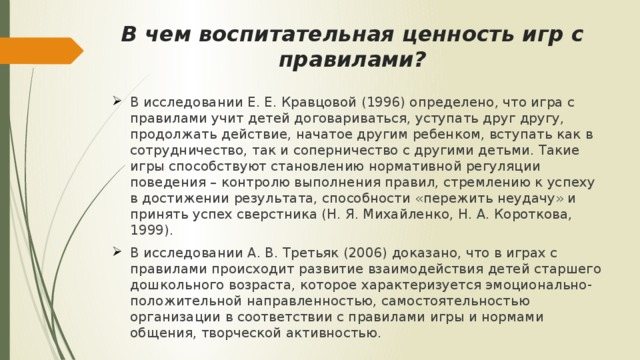
What is the educational value of games with rules?
- In a study by E. E. Kravtsova (1996), it was determined that playing with rules teaches children to negotiate, give in to each other, continue an action started by another child, and enter into both cooperation and competition with other children. Such games contribute to the formation of normative regulation of behavior - control of compliance with the rules, the desire for success in achieving results, the ability to “survive failure” and accept the success of a peer (N. Ya. Mikhailenko, N. A. Korotkova, 1999).
- A study by A. V. Tretyak (2006) proved that in games with rules, interaction between children of senior preschool age develops, which is characterized by an emotionally positive orientation, independent organization in accordance with the rules of the game and communication norms, and creative activity.
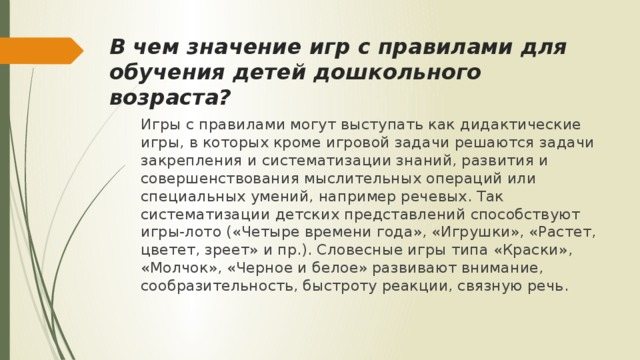
What is the importance of games with rules for teaching preschool children?
Games with rules can act as didactic games, in which, in addition to the game task, the tasks of consolidating and systematizing knowledge, developing and improving mental operations or special skills, such as speech, are solved. Thus, lotto games (“Four Seasons”, “Toys”, “Grows, Blooms, Ripens”, etc.) contribute to the systematization of children’s ideas. Verbal games such as “Paints”, “Silence”, “Black and White” develop attention, intelligence, speed of reaction, and coherent speech.

Thank you for your attention.
Speech development
Play has a very great influence on the development of language. A gaming situation requires a certain level of development of verbal communication from each child participating in it. The need to communicate with peers stimulates the development of coherent speech. In the game, children learn to fully communicate with each other. Younger preschoolers do not yet know how to truly communicate with their peers.
In children of middle and senior preschool age, despite their inherent egocentrism, children agree with each other, both before the role-playing game and in the game itself.
If for some serious reason the joint game breaks down, then the communication process also breaks down.
Play, like other types of activity, requires preschoolers to demonstrate certain moral and volitional qualities and establish contacts with peers.
In order for the game to be successful, the child must have the skills that A.P. Usova called the qualities of “sociability.” She described these skills as the ability to act together, to establish connections with other children, the ability to find one's place among children playing, to take initiative and convince others to accept the game, to be attentive to peers, the ability to influence children not only by organizing them, but also to obey certain requirements peers, take into account their opinions. These qualities are formed and manifested in the process of communication in the joint play of children.
In the game, disputes and conflicts may arise in the process of resolving communicative organizational issues. As noted by N.S. Pantina, children often quarrel not because playing activities lead to the fact that partners have many different ideas about the actions of one or another participant.
The nature of the conflict in the game indicates its development as a joint activity.
Play as a leading activity is of particular importance for the development of the sign function of children's language. Mastery of the sign function of language leads to a radical restructuring of all mental functions of the child. In the game, the development of the sign function occurs through the replacement of one object with another.
In play, the child grasps specific signs of two types: individual conventional signs, which in their sensory properties have little in common with the designated object; iconic signs, the sensory properties of which are visually close to the object being replaced.
Individual conventional signs and iconic signs assume in the game the function of the missing object that they replace.
Moreover, acts of substitution contribute to the child’s development of free use of objects not only in the quality that is acquired in the first years of life, but also in others.
Play as a leading activity is of particular importance for the development of reflective thinking.
Reflection is a person’s ability to analyze his own actions, actions, motives and correlate them with universal human values, as well as with the actions, actions, motives of other people. Reflection contributes to adequate human behavior in the human world.
The game leads to the development of reflection, because in the game there is a real opportunity to control the execution of an action, which is part of the communication process. The dual position of the player - performer and controller - develops the ability to correlate one's own behavior with the behavior of a specific model. Role-playing creates the conditions for reflection as the purely human ability to understand one's own actions, needs and experiences with the actions, needs and experiences of others.
The game contributes to the formation of strong-willed behavior of the child. The mechanism for controlling one’s own behavior—obedience to rules—is formed in the game and then manifests itself in other types of activities. Will presupposes the presence of a pattern of behavior that the child follows and control.
Games that arise on the initiative of children as a form of socialization of preschoolers
Games that arise on the initiative of children as a form of socialization of preschoolers
In preschool age, a child discovers the world of human relationships, different types of activities and social functions of people. He wants to be included in this adult life, to actively participate in it, which, of course, is not available to him. In addition, he strives for independence. From this contradiction, role-playing game is born - an independent activity of children that models the life of adults.
Play is the only central activity of a child that takes place at all times and among all peoples. Play is the practice of child development; in play, a child develops as a personality, he develops those aspects of his psyche on which the success of his educational and work activities, and the success of his relationships with people will subsequently depend. The game reveals the characteristics of the child’s thinking and imagination, emotionality, activity, need for communication, sense of collectivism, determination, humanity, and so on. In addition, play is a unique way of learning social experience, characteristic of preschool age.
In other words, it is in the game that the process of socialization is carried out, that is, the process of formation of the personality of a little person, his assimilation of socio-cultural experience.
According to the Federal State Educational Standard for Education, the leading type of activity in preschool age is play activity. Play is a unique way of assimilating reality and social experience, characteristic of a child. A special place is occupied by games that children themselves create, these are creative or role-playing games.
Playing activity, as a means of socialization of a preschooler, allows you to expand the social horizons of a child’s life, create great scope for the manifestation of his individuality as the fullness of self-realization, freedom of behavior and activity in the social space. The variety of possibilities for gaming activity is manifested in the activation of cognitive abilities, the correction of deficiencies in personal development, the formation of the ability to navigate social reality and intellectually master the entire system of human relations.
These games arise from manipulative games or object-manipulative activities. This type of game is necessary for a child to study the properties of objects, their shape, volume, etc. Manipulative games include rolling a ball, building with blocks, and rolling a car. Subsequently, this type of game is transformed, and certain rules are added to the manipulation of objects; here you can recall the game “Hot Potato”, when a certain imaginary property is added to throwing the ball, it also becomes hot.
Further, the game becomes even more complex; verbal accompaniment is added to the manipulation of objects and imaginary properties, which the child must analyze and give a feedback; such games include the game “Edible - Inedible.”
Subsequently, the game is transformed into a role-playing game; children reproduce everything that they see around them in the lives and activities of adults. In role-playing games, a social motive is laid down, and it becomes an effective means of socializing preschool children and allows the child to take his place in society.
It should be noted that children in orphanages have a low level of play activity; being in unfavorable conditions, children either independently organize destructive play or do not know how to play at all on their own initiative. Teachers of such institutions should show their pupils role-playing games, push their gaming potential, and in the future not interfere with the games that children organize on their own.
In older preschool age, the plot-role-playing game is enriched, a variety of game themes, roles, game actions, and rules introduced and implemented in the game are observed. At this age, construction play begins to turn into work activity. In such games, children learn basic labor skills, learn the physical properties of objects, and actively develop practical thinking. The child appears and develops the ability to plan his actions, improves manual movements and mental operations, imagination and ideas
One of the role-playing games that arise on the initiative of children is the game “Shop”. You can invite children to play this game, while the teacher does not act as a judge or presenter, but plays along with the children, following the same rules that the children follow.
First, the students should be told that today a game of shopping will be organized, everyone will be able to receive a certain amount of money (a fake, candy, etc. at the discretion of the teacher)
and buy yourself a product. The amount of money received depends on the child’s behavior and the good deeds he has performed. The main thing is that at the start of the game each child has money with which he can buy at least one of the goods. The number of goods must correspond to the number of children or be greater; the children will have goods left or they must return them after the end of the game, this is discussed at the beginning of the game.
To summarize the above, it should be noted that childhood without play and outside of play is not normal. Play activity is a “school” of social feelings and collective skills, which contributes to the mastery of ways to comprehend social reality, the accumulation of experience in knowing one’s reserve capabilities, and ensures the development and realization of the child’s potential as a creative subject of social reality. Depriving a child of play practice is depriving him of his main source of development.

